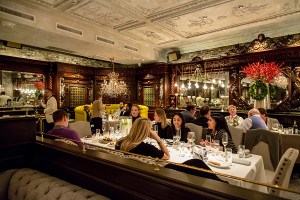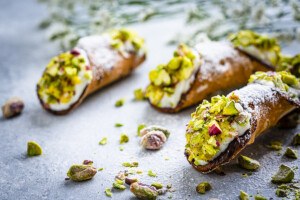Supply Chain: Cheese and Beyond at Formaggio Kitchen

Photographs by Cassandra Landry
It’s a brisk, sunny morning, and a few people zip down Cambridge’s Huron Avenue on their bikes, the street mostly clear except for a construction crew down the way. Inside Formaggio Kitchen, however, it’s creeping up on lunchtime and there’s a steady hum beginning to build. For a few brief minutes, the cheese counter is wide open.
I meet buyer and wholesale manager (and part-time cheesemonger) Julia Hallman, a redhead with a wide grin and fizzy energy, in the bakery kitchen in order to leave the narrow aisles free for perusing early lunchers.
Ihsan and Valerie Gurdal’s—who took over the shop in the early 90s—Formaggio Kitchen is many things. It is, on the surface, a 30-year-old neighborhood specialty shop where you can find a reliable cup of coffee, killer scones, and a great bottle of wine for dinner. But it’s also a fromagerie in a small French village, a dusty spice market in Istanbul, a damp Alpine cheese cave (yes, there is a cave, sitting right beneath your feet), and an Italian olive grove, for starters. For its regulars, this is not a surprise.
“The goal is to be a specialty food store where every item is handpicked and has a story behind it,” Hallman says, the smell of baked goods in the oven beginning to snake through the air around us. “Clearly the focus is cheese, but it goes well beyond that.”
One cursory glance at the shelves, lined with rows and rows of products approaching the ceiling, each bottle or box or tin looking more enticing than the last, proves her point. The shelves of their South End and New York locations give off the same impression.

Photograph by Cassandra Landry
“Ihsan didn’t want to just work with distributors, which is very easy for a lot of chefs to do,” she continues. “He wanted to be a direct importer and work one-on-one with the farmers, cheesemakers, and producers.”
Working directly with individuals has become Formaggio’s trademark and not-so-secret secret to success over the years, endearing them to customers whose tastes run towards the small-batch, the hard-to-find, and the international. It is the sole engine behind the selection of more than 200 varietals of cheese and three stores’ worth of edible treasures from around the globe. It’s also the reason that over 100 restaurant accounts, in Boston and beyond, seek out the little storefront.

Photograph by Cassandra Landry
“Some chefs come in every day. Journeyman, for example. They come in almost every day and taste through cheeses and hand-select everything,” Hallman says. “The cheese buyer for No. 9 Park is very similar. He is very meticulous about what cheeses he brings in, and he understands that the wheels are constantly varying.”
“We also we have chefs who will trust us and leave it in our hands. They understand that we’re eating cheese constantly, so they’ll tell us to pick out two pounds of sheep, two pounds of goat, two pounds of blue, whatever we think is best,” she adds. “It’s funny because we definitely overthink and dissect the pairings and worry about what works well together.”
Marcos Sanchez, the executive chef at Jamaica Plain tapas joint Tres Gatos, came across Formaggio 12 years ago while he was living in Arlington and working in Cambridge. He now makes the trip once a week—often loading his bike with as much as he can carry—and his regular cheese offerings on menu are a reflection of the carefully curated selection sitting atop the counter.
“The relationships that they have with their cheesemakers is, I imagine, by far better than anybody else in the world, really,” he says. “Plus, they age their cheeses really well, and keep them alive. That’s what’s so unique about them, that their cellar also imparts its own style.”
Hallman touches on this too, and explains that being so in tune with the cheese means “you just have to understand that cheese is a living, breathing thing, and constantly be tasting. It’s this ebb and flow, but that’s the fun part.”
“They’re the best source that I can find right now. I’ve tried buying from vendors, and it’s hard because you can’t see the product,” Sanchez says. “It’s so hard for me to buy off of a list. I want to see it, feel it, smell it, and I can do that at Formaggio. They’re the best at what they do.”
Back in the store, the counter is in full swing, with people queuing in small clusters and straining for a look at the minefield of little signs poking out of the hunks and blocks of cheese.
“Having a chef come in and look at you like an expert … that to me is really great for everybody on the counter,” Hallman says. “We really encourage our restaurants to come in and taste through things, and we treat them like customers.
“Which, in our world, what you learn as a cheesemonger from day one is that you only have one customer, and that’s the person standing in front of you,” she continues. “That’s it.”


